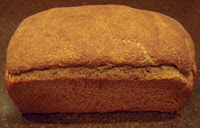
Once again, I've had a very long break in writing. In the meantime, I've taken on a couple of new challenges. As the Hamelman challenge has drawn to a close, the
Mellow Bakers have started up a new challenge to bake through
The Handmade Loaf by Dan Lepard. I haven't created a blog for this yet, but I've made ten recipes from this book, the first four recipes in the challenge along with six others.
I've also created a personal challenge, to bake through Baking Artisan Bread by Ciril Hitz over a period of ten weeks. This book is organized around ten basic formula with variations for each. I'm eight weeks into this challenge and am on schedule. Again, I haven't created a blog for this either. As to this challenge, I'm five posting behind. So, over the past couple of months and done lots of baking but very little writing. So it's time to catch up.
Having previously made Reinhart's whole wheat bagels, for the next recipe I opted to make multigrain and pumpernickel bagels. Using the biga recipe as given, I made half a recipe each of the soakers for the multigrain and pumpernickel bagels. I divided the biga the next day and made two sets of bagels otherwise following the recipe as given. In each case I used the barley malt syrup. With the pumpernickel bagels, I opted for the molasses over sorghum. My memory is a bit hazy at this point. For the grains, I believe I used a Quaker Oats Multigrain cereal. In the photo, these are the ones with the black and white sesame seeds.
Frankly, the results were less than stellar—okay but not exciting. Since bagels tend to be dense and chewy to begin with, the use of whole grains can lead to a very heavy product. This was not my favorite.
 Naan is traditionally made with whole wheat flour so its inclusion in this book makes a lot of sense. On the other hand, naan is typically cooked in a tandoor oven at extremely high temperatures so cooking it at home can be less than optimal.
Naan is traditionally made with whole wheat flour so its inclusion in this book makes a lot of sense. On the other hand, naan is typically cooked in a tandoor oven at extremely high temperatures so cooking it at home can be less than optimal.













